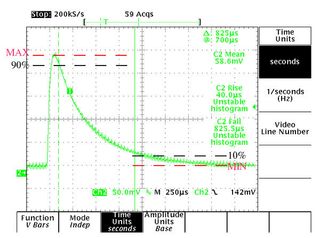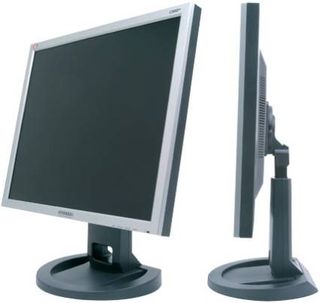The Secret Sauces of THG's LCD Tests
Third Observation: Fade Time
This is similar to measuring the display time. The human eye is actually more sensitive to fade time than display time: a truly white object leaves a trace, which is more annoying than a moving white object that was poorly illuminated during its movement. Following publication of our previous results, some manufacturers haven't hesitated in adopting "preheating" as a solution. This is where they illuminate their pixels to a lower value before any change in color. Once done, they reduce the fade time, but at the detriment of the display time.
On our CRT, the fade time corresponds in effect to screen remanence.

Here we're measuring around 825 microseconds, which is still beyond the reach of the best TFT. The latency of the screen is then determined by adding the display time and the fade time.
Tl = Tf + Tr = 860 µs
Example Of Use: Hyundai L90D+ - TN+film

We previously used the legendary Hercules ProphetView 920 Pro as our monitor of reference. Since then, things have really changed and we're now proposing to distinguish between two sets of figures in the following examples. The first concerns the Hyundai L90D+, which represents today the best implementation of classic TN+ film technology. After that, we'll take a look at the ViewSonic VP191b, our latest monitor of reference. It's a monitor based on a VA overdrive panel and is clearly the best monitor available at the moment.
As far as LCD screens are concerned, we measure the latency of the panel for every possible combination of settings. In effect, the latency deteriorates whenever the transitions are less extreme. When a standard TN pixel is instructed to transition from black to light grey (that's to say from 0 to 150 on a scale up to 255) then it will be less rapid than when the transition is very distinct, from black to saturated white for example (that's to say from 0 to 255).
Stay on the Cutting Edge
Join the experts who read Tom's Hardware for the inside track on enthusiast PC tech news — and have for over 25 years. We'll send breaking news and in-depth reviews of CPUs, GPUs, AI, maker hardware and more straight to your inbox.
Current page: Third Observation: Fade Time
Prev Page First Observation: Refresh Delay Next Page What About The Standards?Most Popular

